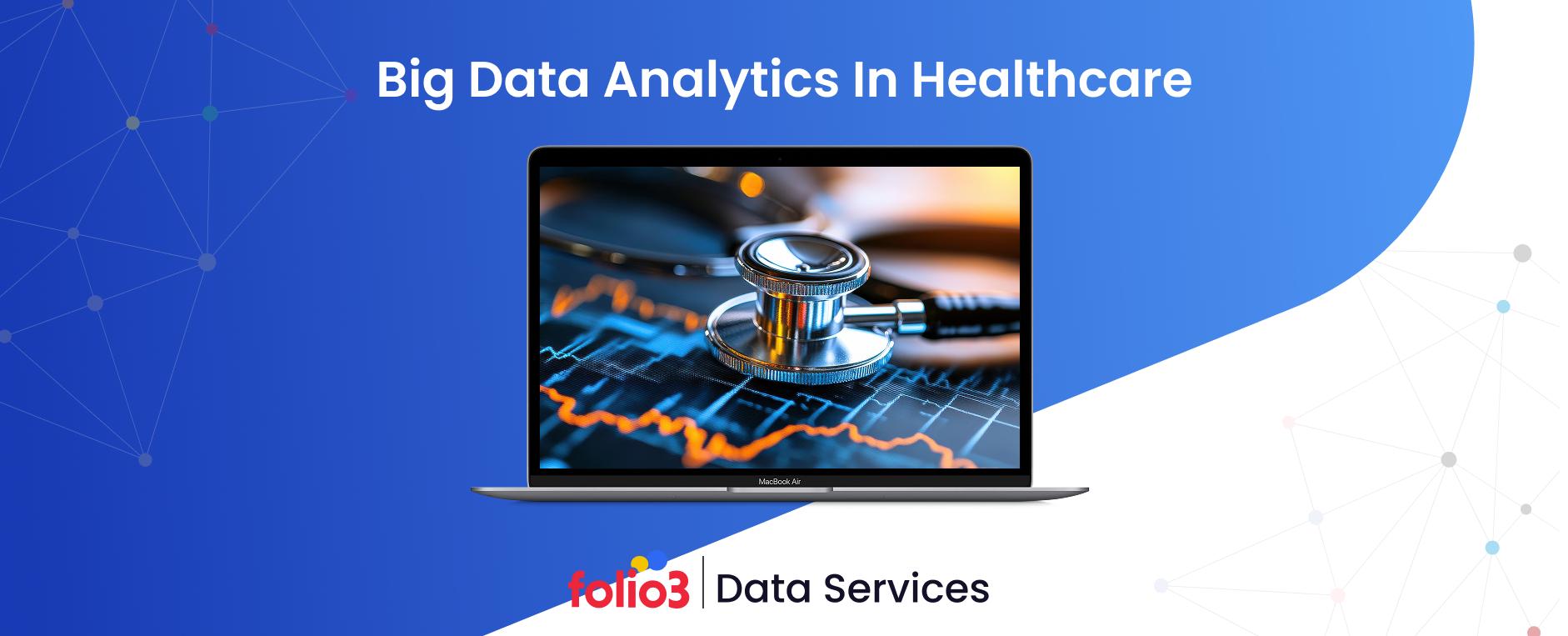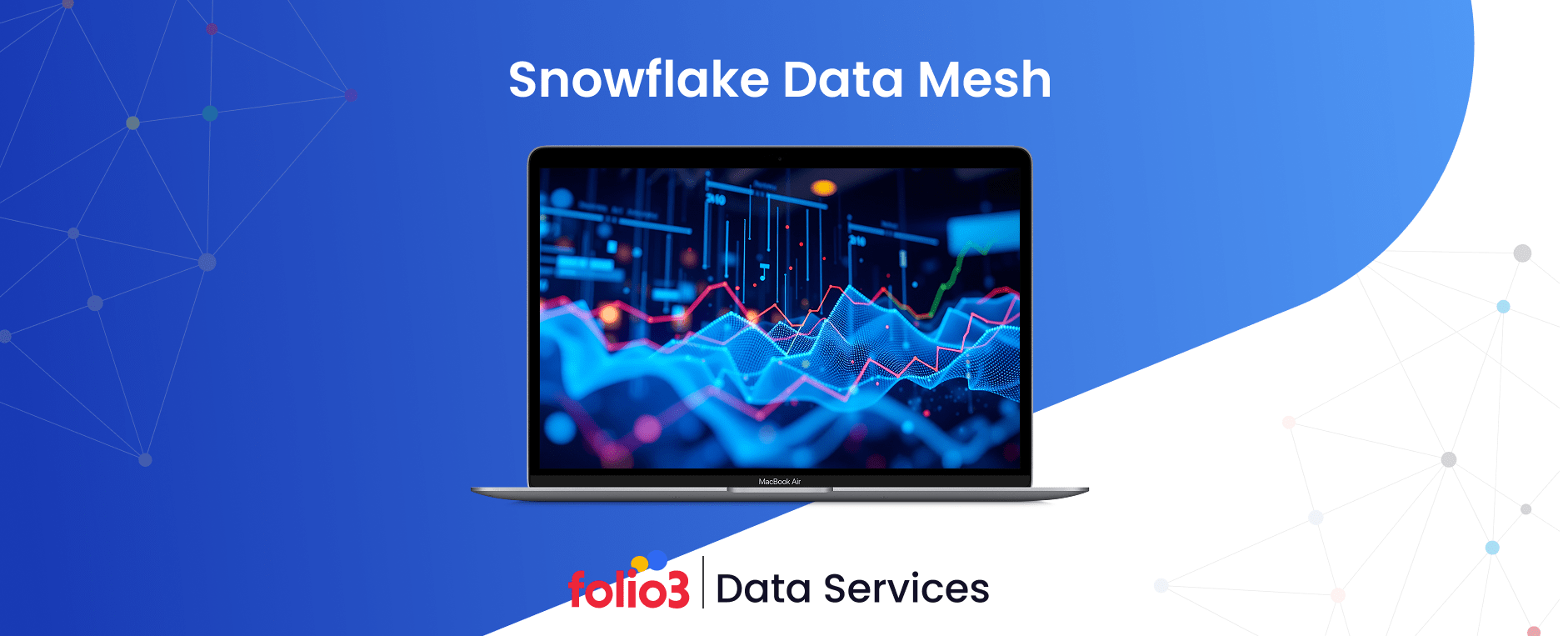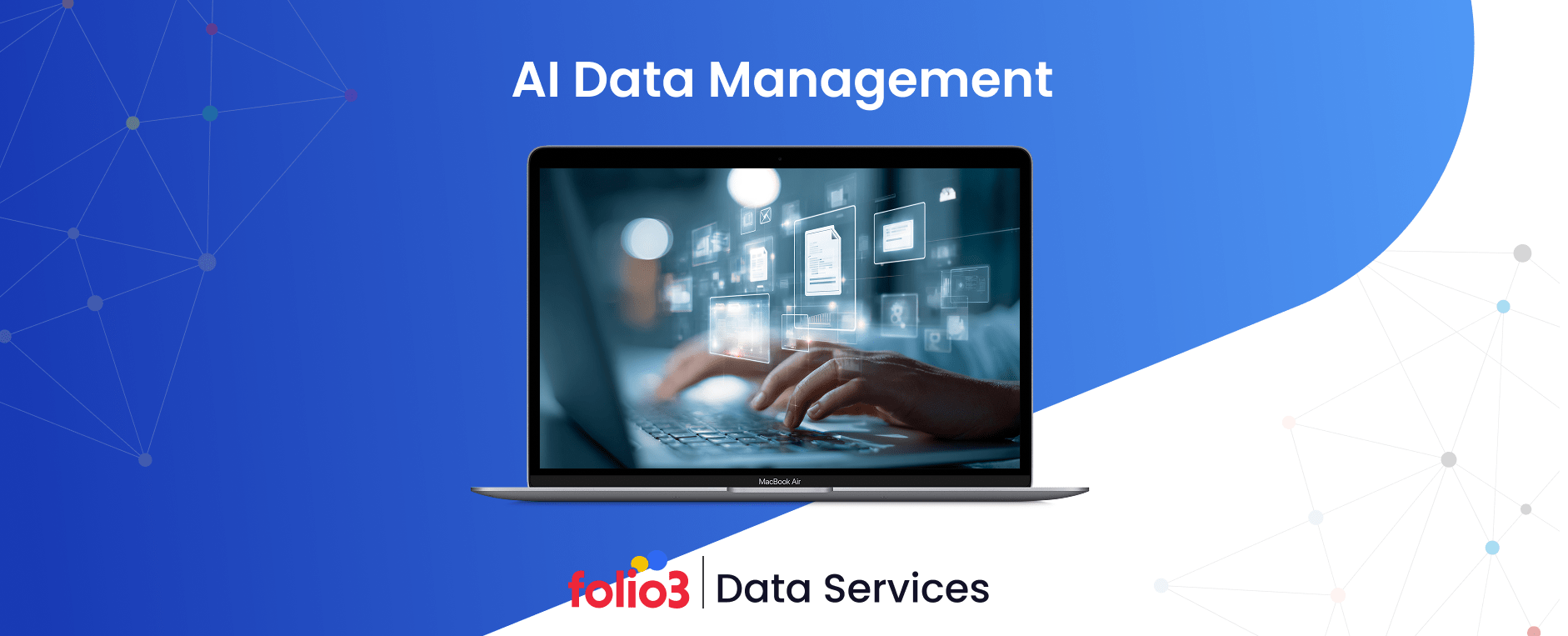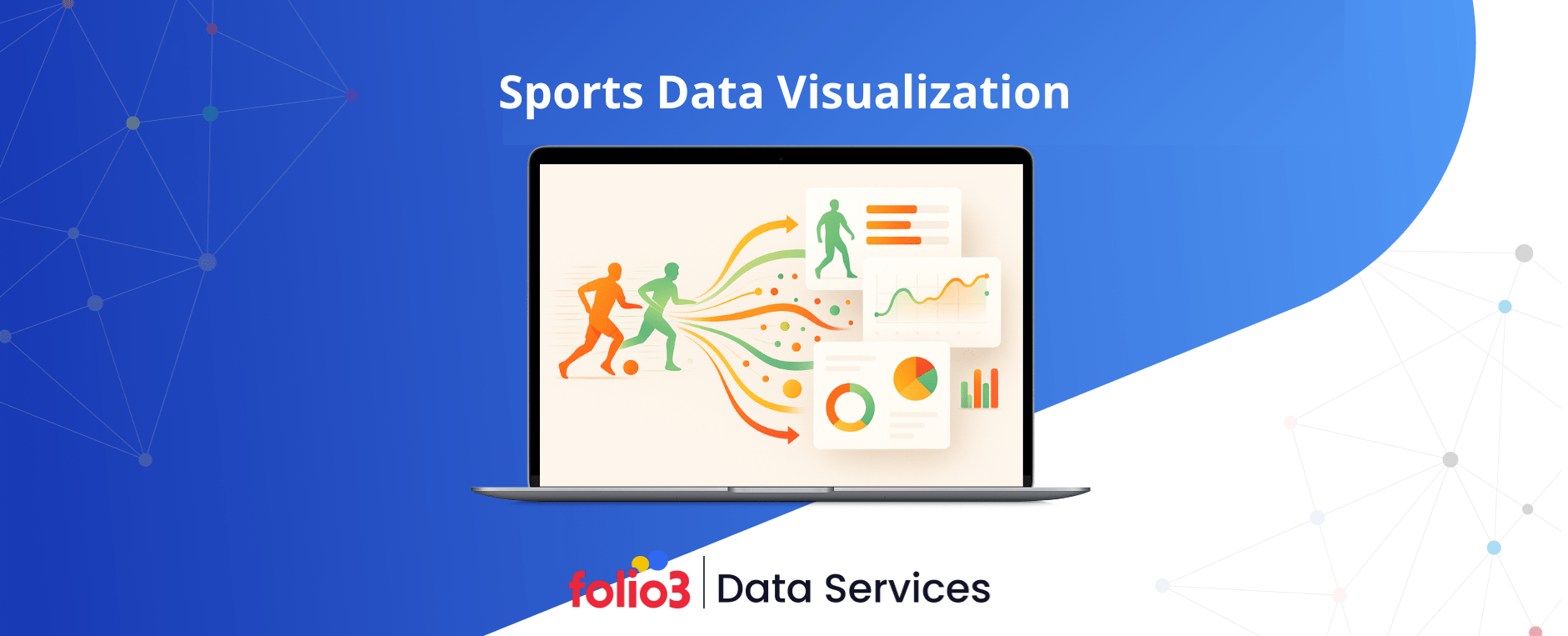Healthcare is one of the fastest-growing generators of data, producing vast amounts of information through electronic health records, imaging, genomics, and wearable devices. However, much of this data remains unused in fragmented systems, offering little value to providers or patients.
Big data analytics in healthcare addresses this challenge by transforming complex datasets into actionable insights that enhance care delivery, improve patient outcomes, and optimize operations. Unlike traditional reporting, healthcare big data analytics uses predictive modeling, machine learning, and natural language processing to uncover patterns and forecast risks.
The big data analytics in the healthcare industry is rapidly expanding, driven by the demand for personalized treatments, efficient resource allocation, and value-based care models. This blog examines how big data is transforming healthcare, from its benefits and applications to real-world case studies, challenges, and future trends, enabling organizations to leverage data as a strategic asset for delivering smarter, patient-centric care.
What is Big Data Analytics in Healthcare?
Big data analytics in healthcare is the practice of examining massive, complex datasets from diverse sources to uncover patterns, correlations, and insights that improve patient care, streamline operations, and guide health policies. Unlike traditional analytics, it addresses the five Vs:
- Volume (huge datasets),
- Velocity (real-time generation),
- Variety (structured and unstructured data),
- Veracity (accuracy),
- Value (actionable outcomes).
Healthcare big data encompasses clinical records, lab results, imaging, genetic sequencing, billing data, operational metrics, and even patient-generated data from wearable devices and mobile applications.
The power lies in unifying these data streams into holistic views, revealing connections that remain hidden in isolation. Building a big data pipeline enables the continuous flow, transformation, and integration of diverse healthcare data sources into actionable insights.
For example, linking genomic data with treatment outcomes enables the development of personalized therapies tailored to specific genetic profiles. This transformation is powered by advanced tools, including distributed computing, machine learning, and intuitive visualization platforms, which make healthcare big data analytics both actionable and accessible.
How Does AI Play a Role in Healthcare Big Data Analytics?
Artificial intelligence (AI) has become essential to big data analytics in healthcare, where the sheer volume and complexity of medical data exceed human capacity. By combining machine learning, predictive modeling, and natural language processing, AI unlocks actionable insights that transform care delivery, efficiency, and outcomes.
Together, big data and analytics in healthcare, powered by AI, are reshaping diagnostics, risk management, and clinical decision-making, helping to drive the benefits of data analytics in healthcare across patient care and operational efficiency:
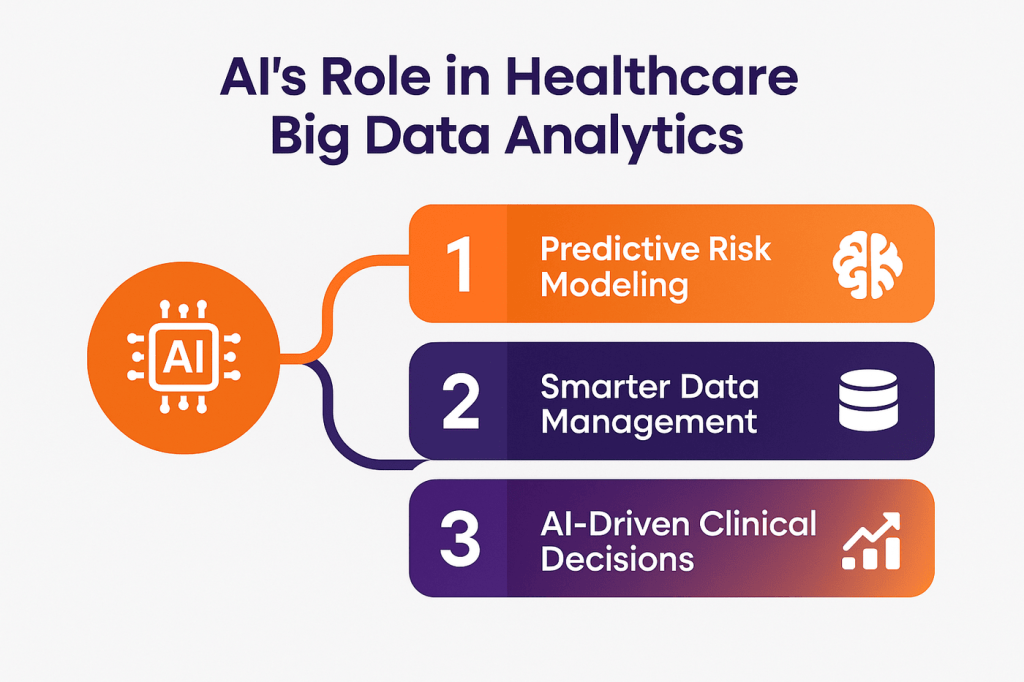
1. Predictive Risk Modeling
One of the most powerful big data applications in healthcare is predictive analytics. AI identifies patterns that forecast risks such as hospital readmissions, disease progression, or adverse drug reactions. Johns Hopkins Hospital, for example, deployed AI-driven sepsis prediction models that detect risks up to 48 hours before symptoms appear, significantly improving survival rates. Such healthcare big data analytics enables proactive intervention instead of reactive treatment.
2. Intelligent Data Management
Data fragmentation is a significant barrier in big data analytics in the healthcare industry. AI-powered data management solutions integrate fragmented information from electronic health records, imaging, and patient-generated data, thereby enhancing the overall quality of care. Implementing effective healthcare data integration strategies ensures seamless connectivity across disparate systems.
Natural language processing (NLP) further extracts insights from unstructured clinical notes, which comprise nearly 80% of the big data in healthcare. AI also enhances data accuracy by identifying anomalies, thereby providing higher-quality inputs for informed decision-making.
3. AI-Powered Clinical Decisions
AI-driven decision support enhances clinician judgment with data-backed insights. Google Health’s AI for diabetic retinopathy, trained on 128,000 images, matches specialist accuracy while enabling faster, more accessible screenings. Similarly, Memorial Sloan Kettering leverages IBM Watson to match cancer patients with relevant treatments and clinical trials.
Behind these capabilities, AI in data engineering ensures efficient data preparation, integration, and processing, enabling clinical AI models to access clean, structured, and reliable datasets that drive accurate decision-making.
What Are the Benefits of Big Data Analytics in Healthcare?
Big data analytics in healthcare delivers value across clinical, operational, and financial dimensions, helping providers improve outcomes, streamline operations, and reduce costs. The big data analytics in the healthcare industry is rapidly evolving as organizations embrace advanced analytics to transform patient care and research.
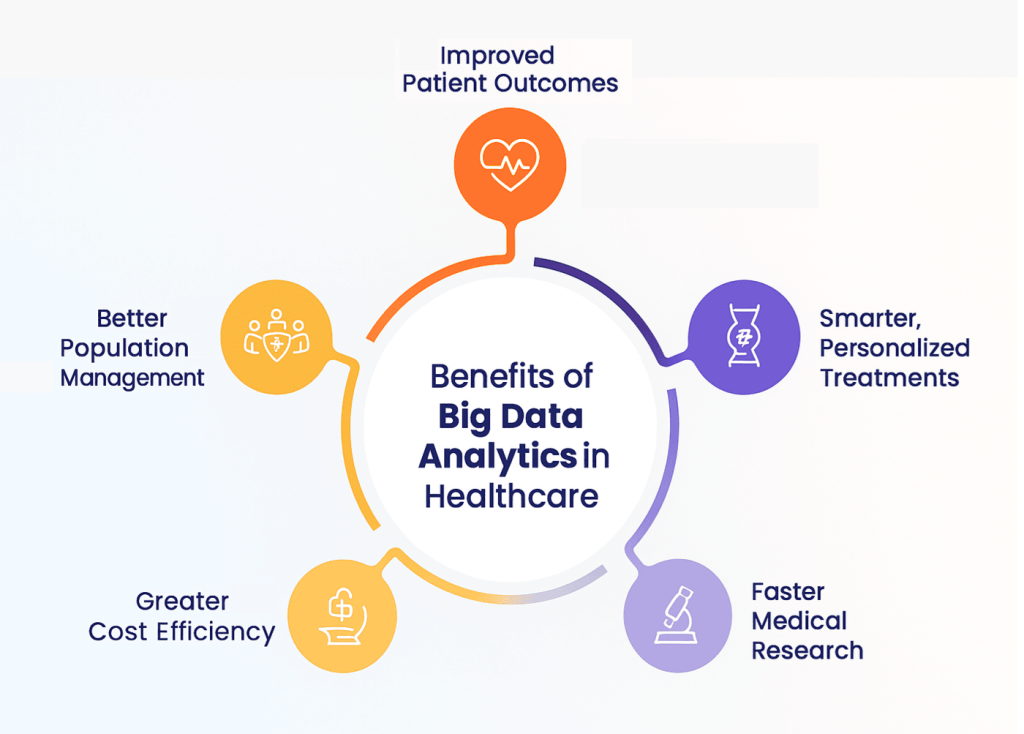
1. Better Patient Outcomes
The most significant benefit of big data analytics in healthcare is the improvement of patient health outcomes. Big data predictive analytics helps identify at-risk individuals earlier by analyzing diverse datasets such as medical history, lab results, and lifestyle factors.
Predictive models can detect chronic disease risks early, such as identifying prediabetic patients, allowing for preventive interventions. Analytics also reduces medical errors. For instance, hospitals that use advanced screening systems have reduced adverse drug events by 20%, improving safety and saving billions of dollars annually.
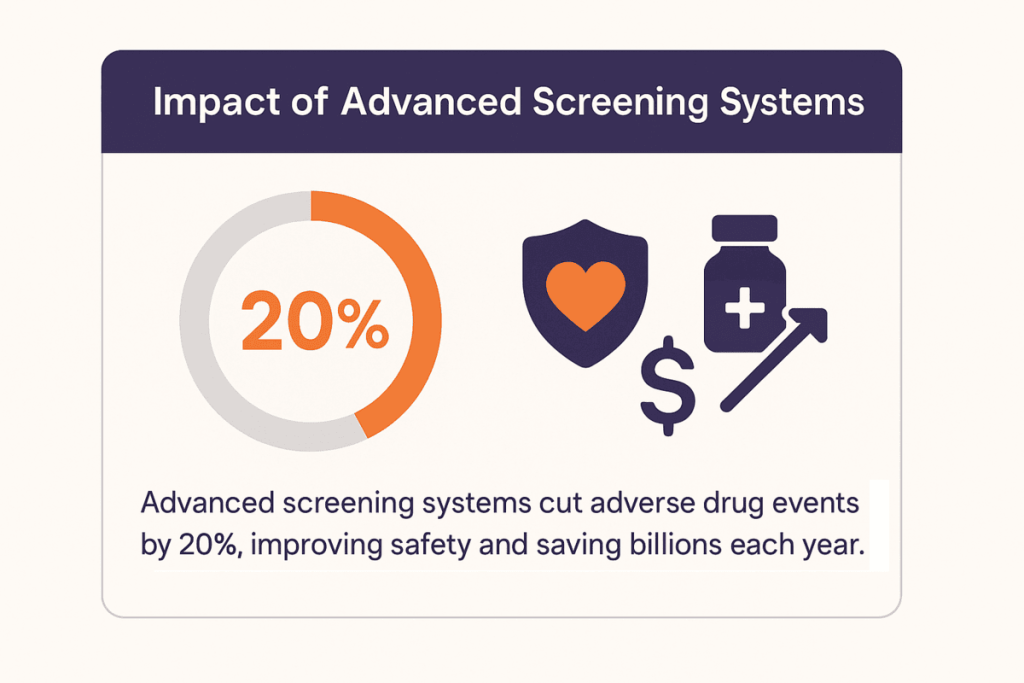
2. Smarter Treatment Plans
Big data in healthcare enables personalized medicine by aligning treatments with genetic markers, biomarkers, and a patient’s medical history. Oncology leads this trend, and genomic profiling allows oncologists to match cancer therapies to specific mutations, significantly improving survival rates. Continuous monitoring tools, such as glucose sensors, also enable real-time adjustments to treatment.
3. Accelerated Medical Research
Big data applications in healthcare accelerate clinical research by analyzing massive datasets, rather than relying on lengthy trials. During the COVID-19 pandemic, healthcare big data analytics enabled the identification of high-risk populations, tracked the spread of the virus, and facilitated the repurposing of drugs, all within months rather than years.
4. Cost and Resource Efficiency
Hospitals use big data in healthcare analytics to optimize staffing, reduce wait times, and minimize waste in supply chains. Predictive modeling also lowers costly readmissions, cutting rates by 15–25% in many systems.
Advanced predictive analytics in healthcare helps identify at-risk patients before complications occur, significantly reducing emergency department visits.
5. Population Health Management
By analyzing entire populations, healthcare big data analytics enables proactive interventions, efficient resource allocation, and better public health monitoring. From tackling the opioid epidemic to managing chronic diseases, big data use cases in healthcare demonstrate its power to improve both community and individual well-being.
Turn complex healthcare data into insights that improve quality, efficiency, and patient satisfaction.
Real-World Applications of Big Data in Healthcare
Big data analytics in healthcare is transforming clinical care, research, operations, and financial management by turning massive datasets into actionable insights. These big data applications in healthcare are reshaping how organizations deliver outcomes while controlling costs.
Predictive Risk Analytics
Hospitals use predictive analytics techniques to anticipate patient deterioration, enabling timely interventions. The University of Pennsylvania Health System developed early warning scores based on vital signs and laboratory results, reducing ICU transfers through proactive care. Chronic disease programs also leverage predictive analytics to prevent complications and reduce ER visits.
Clinical Research Acceleration
Healthcare big data analytics accelerates medical research by enabling large-scale studies beyond traditional trial designs. The FDA’s Sentinel Initiative analyzes data from over 100 million patients to detect rare drug safety issues faster (FDA Sentinel). Similarly, PCORnet connects 100M+ patients across systems for comparative effectiveness research (PCORnet).
Hospital Operations Optimization
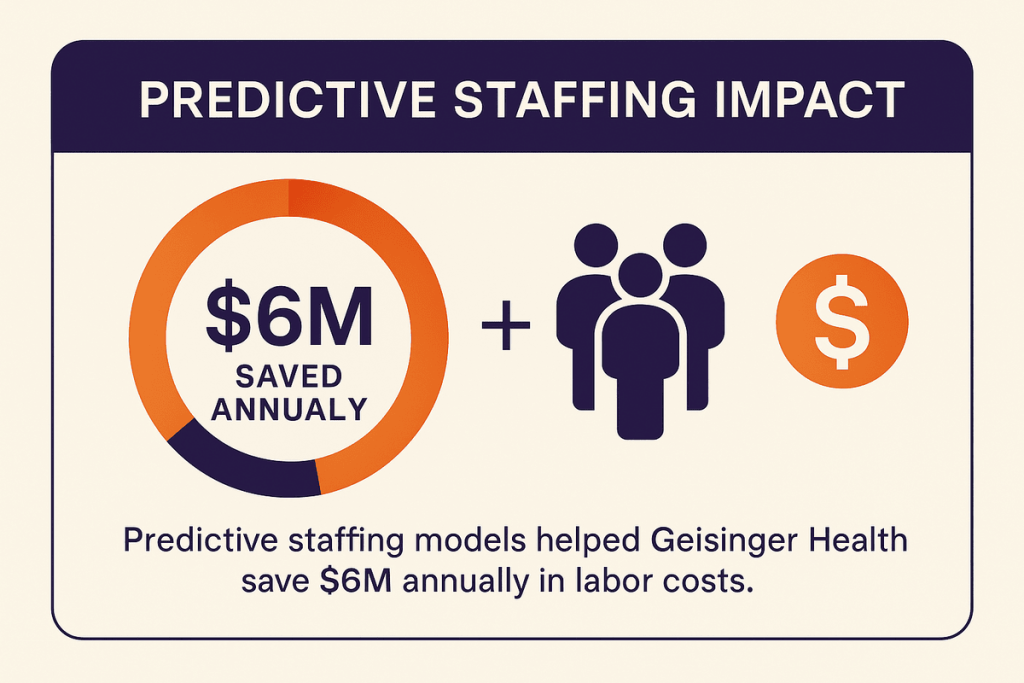
Operational analytics improve efficiency in scheduling, staffing, and resource use. Geisinger Health System reduced labor costs by $6 million annually through the use of predictive staffing models. Analytics also optimize OR scheduling by predicting surgery times more accurately, minimizing delays and overtime.
Effective healthcare supply chain analytics further reduces waste and ensures optimal inventory levels across hospital networks.
Remote Patient Monitoring
IoT-driven monitoring empowers patients and care teams. Livongo’s connected glucose meters improve diabetes control through real-time analytics in healthcare.
Remote heart failure monitoring prevents costly hospitalizations by detecting early warning signs, enabling proactive interventions before conditions worsen.
Value-Based Care Models
Big data supports accountable care by tracking outcomes, costs, and quality metrics, enabling more informed decision-making. The Medicare Shared Savings Program utilizes analytics to help providers enhance their performance and reduce expenses.
Implementing business intelligence in healthcare enables providers to monitor quality measures, identify care gaps, and optimize reimbursement in value-based models.
Key Challenges in Healthcare Big Data
While the benefits of big data in healthcare are undeniable, organizations often face significant hurdles when deploying analytics solutions. Addressing these challenges is critical for unlocking the full potential of healthcare big data analytics.
1. Data Privacy and Security
Patient data is among the most sensitive types of information and is tightly regulated under HIPAA in the U.S. and GDPR in Europe. Healthcare organizations must balance analytics needs with compliance obligations, making data privacy in healthcare big data a persistent concern.
Implementing robust healthcare data security measures is essential to protect patient information from breaches and cyberattacks.
In 2023 alone, over 725 data breaches exposed more than 133 million patient records, highlighting the sector’s vulnerability to cyberattacks. While de-identification techniques reduce risks, they often limit analytical value. Strong governance and advanced security measures are therefore essential.
2. Integration and Interoperability
Healthcare data is notoriously fragmented across EHRs, lab systems, billing platforms, and imaging archives. Even with standardization initiatives, interoperability remains a significant roadblock. Integrating this data into unified platforms requires complex ETL processes and consumes nearly half of IT budgets.
Mergers and acquisitions only worsen the issue, creating multiple EHR instances within a single organization. Without seamless integration, healthcare providers struggle to gain a comprehensive view of their patients.
3. Data Quality and Standardization
The effectiveness of healthcare analytics relies heavily on the quality of the data. Common issues include missing values, duplicate records, and inconsistent coding.
For example, one clinician might record “CHF,” another “congestive heart failure,” and another “heart failure with reduced ejection fraction.” Proper data processing in healthcare includes standardization, validation, and cleansing to ensure accurate analytics and reliable insights.
Such variations complicate condition tracking without advanced natural language processing (NLP). While standards such as SNOMED CT, LOINC, and RxNorm aim to unify data, their adoption remains inconsistent, slowing progress in big data standardization in healthcare.
4. Skilled Workforce Shortage
Implementing effective big data healthcare solutions requires professionals with expertise in both clinical knowledge and data science, which is a rare and highly sought-after combination of skills. The U.S. Bureau of Labor Statistics projects that healthcare informatics jobs will grow 32% between 2024 and 2034, yet the talent pool remains limited.
Many organizations turn to healthcare data analytics consulting services to bridge this gap by leveraging teams with both technical and clinical expertise.
Proven Strategies for Successful Big Data Analytics in Healthcare
To maximize the value of big data analytics in healthcare, organizations must adopt strategies that address both technical and organizational challenges. By following these strategies, healthcare organizations can develop sustainable, secure, and high-impact big data healthcare solutions that drive improved patient outcomes and operational efficiency.
The following approaches have consistently proven effective:
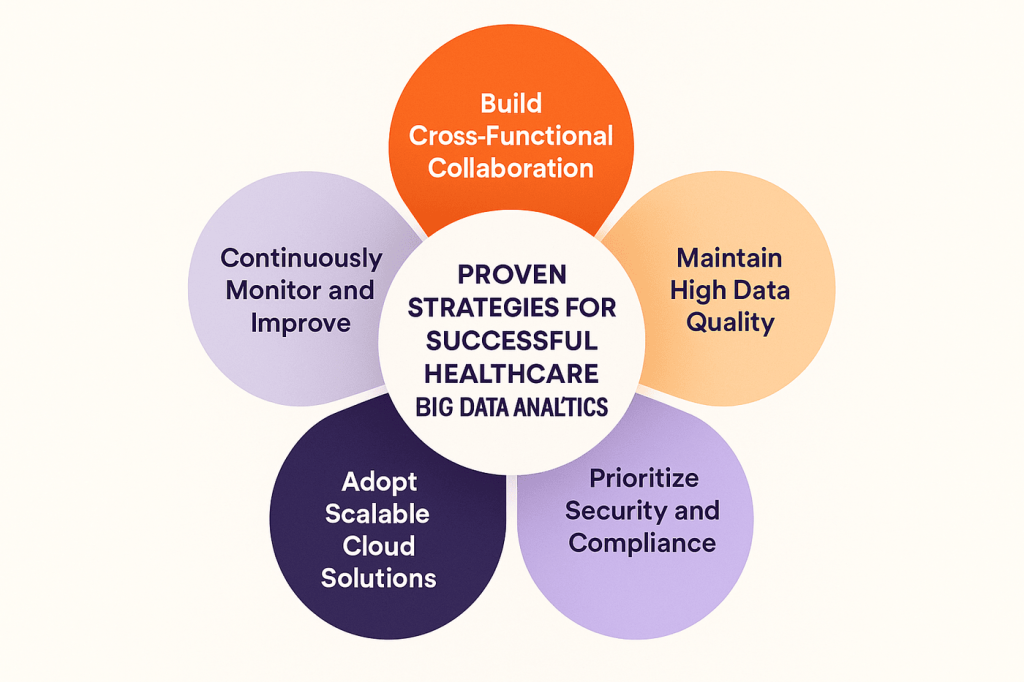
1. Build Cross-Functional Teams
Effective healthcare big data initiatives require collaboration between clinicians, data scientists, IT professionals, and business leaders. Clinicians provide domain expertise, data scientists design analytical models, IT ensures system performance, and leadership aligns efforts with broader strategy. Including clinical champions is especially important, as they promote adoption and help integrate analytics into everyday workflows, ensuring smoother big data implementation across departments.
2. Ensure Data Quality
High-quality data is the backbone of reliable analytics. Organizations should implement validation rules, routine audits, and feedback loops to minimize errors and inconsistencies.
Integrating a strong data governance strategy helps maintain consistency across data sources and ensures that data policies, ownership, and quality controls are enforced effectively.
Master data management ensures accurate patient identification, standardized coding, and consistent provider attribution across systems. By prioritizing data quality in healthcare big data analytics, organizations build a trusted foundation for clinical and operational insights.
3. Adopt Security-First Practices
Given healthcare’s vulnerability to cyberattacks, data privacy and security in healthcare big data must be designed into analytics systems from the outset. Key practices include end-to-end encryption, role-based access controls, and detailed audit logging. Privacy-preserving approaches such as federated learning or differential privacy further enable insights without compromising sensitive patient data. Regular security assessments help organizations stay ahead of evolving threats.
4. Implement Flexible Cloud Solutions
Cloud-based healthcare analytics solutions provide scalability, cost efficiency, and faster deployment compared to on-premises systems. With HIPAA-compliant and secure cloud services, organizations can use advanced tools for machine learning, visualization, and predictive modeling.
A well-planned data lake implementation further enhances flexibility by enabling seamless integration of structured and unstructured healthcare data from multiple sources.
Hybrid cloud strategies strike a balance between security and adaptability, keeping sensitive data on-premises while leveraging cloud power for large-scale computations.
5. Continuous Monitoring and Validation
Analytics models must evolve in response to changes in patient populations, medical practices, and healthcare environments. Continuous monitoring ensures accuracy, while validation processes such as testing against recent data and clinical review help maintain reliability. Feedback loops refine predictive models over time, ensuring that big data in healthcare continues to deliver actionable insights.
Big Data Platforms and Solutions for Healthcare
Implementing big data analytics in healthcare requires a customised mix of platforms and solutions that can effectively handle complex, sensitive, and high-volume data. From traditional data warehousing to AI-powered systems, healthcare organizations have various options available, depending on their specific needs and requirements.
1. Data Warehousing and ETL Platforms
Data warehouses remain the backbone of healthcare data analytics, consolidating information from EHRs, billing systems, and clinical records into a central repository for insights. Cloud-based platforms like Snowflake, Google BigQuery, and Amazon Redshift are popular due to their scalability and performance.
Understanding Snowflake healthcare capabilities helps organizations leverage cloud infrastructure for secure, compliant analytics at scale.
ETL (Extract, Transform, Load) tools such as Informatica, Talend, and SQL Server Integration Services standardize and load data for analysis. Increasingly, organizations are adopting ELT strategies, where raw data is stored in data lakes and transformed within the analytics platform, offering flexibility and preserving original datasets.
Understanding the differences between ETL and ELT helps healthcare organizations choose the right approach for their data processing needs.
2. Real-Time Analytics and Streaming
Certain healthcare use cases, such as ICU monitoring, early sepsis detection, and operational dashboards, require immediate insights. Platforms such as Apache Kafka, Apache Flink, and cloud services like AWS Kinesis or Azure Stream Analytics process data streams in real time. These enable continuous monitoring, pattern detection, and instant alerts to improve patient safety and operational responsiveness.
Real-world healthcare dashboard examples include real-time patient monitoring systems and hospital command centers that visualize critical metrics for faster decision-making.
3. AI and Machine Learning Frameworks
AI in healthcare analytics drives predictive modeling, medical imaging analysis, AI data extraction, and natural language processing of clinical data.
Frameworks like TensorFlow, PyTorch, and scikit-learn are widely used. At the same time, cloud providers (Google Cloud Healthcare API, AWS HealthLake, Azure Healthcare APIs) offer managed AI/ML services tailored for healthcare needs. AutoML tools further simplify model development for teams with limited data science expertise.
4. Healthcare-Specific Analytics Platforms
Vendors like Health Catalyst and Arcadia.io offer platforms specifically designed for population health management, care variation analysis, and value-based care. Meanwhile, Oracle Cerner integrates analytics with EHR systems, strengthening clinical decision-making.
These platforms often rely on robust data engineering in healthcare to ensure seamless data integration, transformation, and accessibility across clinical and operational systems.
5. HIPAA-Compliant Cloud Infrastructure
Cloud providers, including AWS, Azure, and Google Cloud, offer HIPAA-compliant infrastructure with Business Associate Agreements (BAAs) in place. These services provide secure, scalable environments for healthcare analytics, supporting data integration, storage, and machine learning without the cost and complexity associated with on-premises systems.
Healthcare Big Data vs. Traditional Healthcare Analytics – A Side-by-Side Comparison
As healthcare organizations increasingly adopt digital technologies, the distinction between big data analytics in healthcare and traditional healthcare analytics has become critical. While both approaches provide valuable insights, they differ in scale, methodology, and impact. The table below highlights the key differences to help organizations decide when to apply each approach.
| Aspect | Healthcare Big Data Analytics | Traditional Healthcare Analytics |
| Data Volume | Petabytes of data from multiple sources (EHRs, imaging, IoT devices, wearables, claims, etc.) | Gigabytes of structured data from primary systems (EHRs, billing, lab results) |
| Data Variety | Structured, semi-structured, unstructured, and real-time data streams | Primarily structured records stored in relational databases |
| Processing Approach | Distributed parallel processing with big data frameworks, cloud platforms, and data lakes | Centralized databases, batch ETL, and BI systems |
| Analytics Methods | Machine learning, AI, predictive modeling, natural language processing, and advanced algorithms | Descriptive and diagnostic analytics, reporting, and fundamental statistical analysis |
| Time to Insight | Real-time or near-real-time insights, enabling proactive decision-making | Batch processing daily, weekly, or monthly reporting |
| Use Cases | Predictive risk modeling, personalized medicine, population health, remote monitoring, fraud detection | Compliance tracking, financial reporting, utilization monitoring, and regulatory audits |
| Infrastructure | Cloud-based platforms (AWS, Azure, Google Cloud) with scalable storage and compute power | On-premises data warehouses and traditional BI tools |
| Implementation | High complexity requires governance, interoperability, and advanced integration | Moderate complexity established, standardized practices |
| Cost Structure | Variable cloud costs that scale with usage | Fixed infrastructure investments and licensing costs |
| Skill Requirements | Data scientists, ML engineers, cloud architects, and healthcare informatics specialists | BI analysts, database administrators, and IT managers |
Healthcare Big Data Analytics: Real-World Case Studies
Real-world applications of big data analytics in healthcare demonstrate how organizations worldwide are transforming care delivery, population health management, and resource optimization. These case studies highlight practical big data use cases in healthcare that deliver measurable results.
Keralty (Colombia) – Population Health and Decision Support
Keralty, serving over 4 million members in Latin America, deployed a unified healthcare big data analytics platform to address fragmented data and improve care coordination. By integrating EHRs, claims, lab, and pharmacy data, the system enabled real-time dashboards, predictive risk stratification, and embedded decision support.
Results included a 15% reduction in emergency department visits, better medication adherence through predictive alerts, and improved resource allocation. The platform also supported Colombia’s transition toward value-based care models by tracking quality metrics and care gaps.
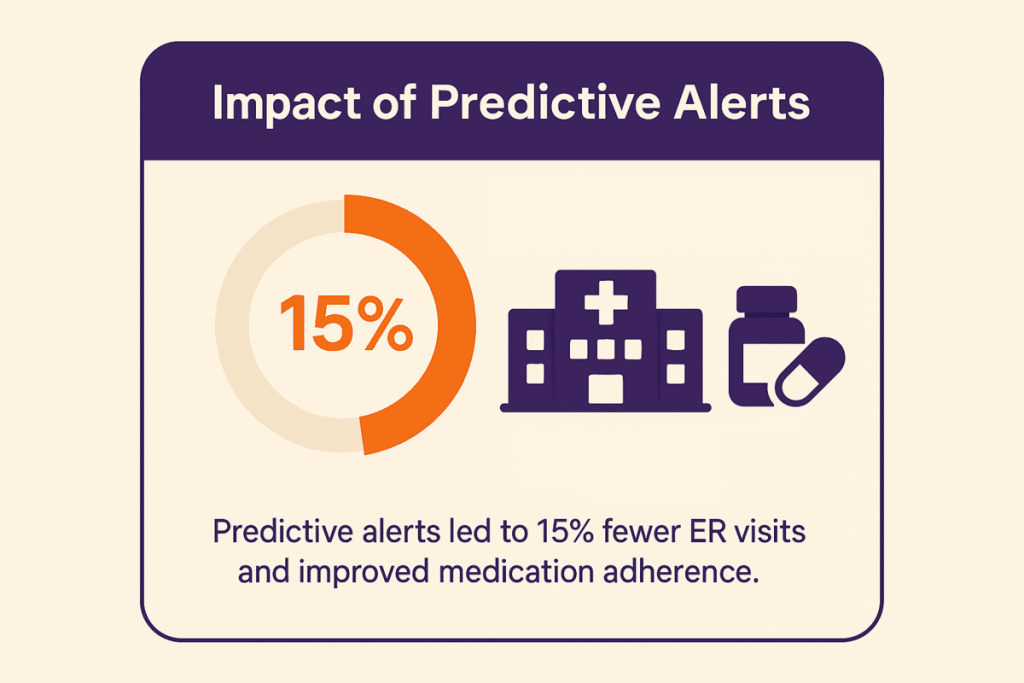
Medical Big Data Warehouse (Algeria) – Optimizing Resource Distribution
A national initiative in Algeria built a medical big data warehouse to streamline hospital resource use and improve access to specialized care. By consolidating hospital, supply chain, and referral data, the platform revealed that some facilities had underutilized diagnostic equipment, while others faced shortages.
These insights informed equipment-sharing programs, smarter capital investments, and more efficient supply chains. Analytics also identified geographic barriers to specialty care, leading to the launch of telemedicine programs that connected rural patients with urban specialists.
Mount Sinai Health System (USA) – Predictive Analytics for Patient Care
New York’s Mount Sinai Health System developed “Windshield,” a predictive analytics platform that integrates EHR, claims, lab, and social determinants of health data. The system generates personalized risk scores for outcomes, including readmissions and complications from chronic diseases.
Care teams utilize these insights for proactive outreach, medication management, and monitoring, resulting in an 18% reduction in 30-day readmissions and an increase in patient satisfaction. Mount Sinai also utilizes predictive analytics to enhance operational efficiency, including forecasting patient census to optimize staffing. Crucially, analytics were embedded directly into the EHR workflow, ensuring adoption and real-world impact.
How Do You Choose the Right Big Data Analytics Partner?
Healthcare organizations are increasingly relying on external partners to implement big data analytics in healthcare, as these projects require specialized skills across compliance, data engineering services, and clinical workflows. Choosing the right partner can determine whether an analytics initiative delivers measurable outcomes or remains a costly experiment.
Key Capabilities to Look For
When evaluating vendors, consider their technical expertise, domain knowledge in healthcare, and track record with organizations similar to yours. A strong partner should understand EHR integration, healthcare compliance requirements (including HIPAA, GDPR, and FDA), and common challenges such as fragmented data and inconsistent quality.
Purely technical expertise without clinical context often results in solutions that don’t align with real-world workflows. Equally important is the implementation approach. Agile methodologies with iterative deliverables provide faster value compared to rigid waterfall models. Look for evidence of incremental success and precise business alignment in past projects.
Why Folio3 Stands Out
Folio3 offers data analytics services that bridge advanced technical capabilities with deep healthcare expertise. The team’s strength lies in translating complex datasets into actionable intelligence, whether for population health, predictive risk modeling, or operational efficiency.
With proven experience in cloud platforms (AWS, Databricks & Snowflake consulting) and AI-driven analytics, Folio3 helps organizations unlock real-time insights while ensuring regulatory compliance.
Unlike partners who prioritize technology for its own sake, Folio3 emphasizes measurable outcomes. Projects begin with clearly defined success metrics and a well-defined use case, ensuring that analytics initiatives directly improve patient outcomes, cost efficiency, or decision-making. Special attention is given to data governance and quality frameworks, laying a sustainable foundation for long-term analytics maturity.
Questions to Ask Before Choosing a Partner
- Can you share case studies with measurable outcomes in healthcare analytics?
- How do you ensure knowledge transfer to internal teams?
- What is your approach to balancing custom development vs. commercial platforms?
Build vs. Buy: Finding the Balance
Healthcare organizations must decide between building custom solutions or adopting pre-built platforms. While off-the-shelf tools offer speed, custom development supports unique needs. Many adopt a hybrid strategy in using commercial solutions for standard functionality while building tailored components for differentiation.
Ensure your healthcare analytics initiative succeeds with a partner focused on compliance, integration, and real-world outcomes.
What Does the Future Hold for Healthcare Big Data Analytics?
The future of healthcare big data analytics is being shaped by technologies that promise more personalized care, real-time decision-making, and stronger privacy safeguards.
Genomic Data and Precision Medicine
With genome sequencing now under $1,000, integrating genetic data with clinical records is becoming practical. This shift drives precision medicine, where treatments are tailored to individual genetic profiles.
Beyond oncology, genomics is advancing pharmacogenomics, rare disease diagnosis, and preventive care for conditions like cardiovascular disease. Large-scale initiatives, such as the All of Us Research Program, highlight how big data platforms enable breakthroughs in precision medicine.
Real-Time IoT and Edge Analytics
The rise of IoT in healthcare is transforming patient monitoring. Devices equipped with AI chips can process data locally, reducing latency and transmitting only critical alerts. Hospitals are deploying edge analytics to detect deterioration patterns more quickly, reduce false alarms, and support timely interventions, all while enhancing data privacy and improving bandwidth efficiency.
Federated Learning and Privacy-First AI
As data privacy remains critical, federated learning enables AI models to train across distributed datasets without requiring the transfer of sensitive patient information. Combined with privacy-enhancing technologies such as homomorphic encryption and differential privacy, this approach supports collaborative research while ensuring compliance with stringent regulations.
Emerging frameworks for generative AI implementation are also being explored alongside federated learning to create synthetic yet privacy-safe datasets that further strengthen AI model training without compromising security.
Advanced Interoperability Standards
Standards such as FHIR and USCDI are enhancing data exchange across EHR systems, reducing integration costs and accelerating the adoption of analytics. While challenges in data quality persist, interoperability is set to fuel faster insights and more connected care.
FAQs
What is big data analytics in healthcare, and how does it work?
Big data analytics in healthcare involves processing massive datasets from EHRs, IoT devices, and labs to uncover insights. It operates by utilizing advanced algorithms, cloud platforms, and AI to enhance patient outcomes and operational efficiency.
How is healthcare big data different from traditional clinical data analytics?
Healthcare big data utilizes large, unstructured, and real-time data streams, using AI and machine learning, whereas traditional clinical data analytics primarily focuses on structured, retrospective records. This enables big data to be more predictive and personalized in healthcare delivery.
What are the main benefits of using big data analytics for hospitals and health systems?
The benefits of healthcare big data analytics include better patient care, predictive insights, cost reduction, and improved operational performance. Hospitals can optimize treatments, enhance workflows, and achieve higher quality outcomes.
Can healthcare big data analytics reduce costs and operational inefficiencies?
Yes, big data analytics in healthcare reduces costs by streamlining workflows, preventing unnecessary readmissions, and improving resource allocation. It helps eliminate inefficiencies through predictive modeling and real-time monitoring.
What are the top real-world use cases of big data in healthcare delivery?
Big data in healthcare delivery is applied in population health management, predictive risk scoring, precision medicine, and operational efficiency. Hospitals use it for clinical decision support, supply chain optimization, and patient engagement.
How is predictive analytics applied to disease prevention and early diagnosis?
Predictive analytics in healthcare identifies at-risk patients using big data from medical history, genetics, and IoT monitoring. This enables early diagnosis and preventive interventions that reduce disease progression.
Which big data tools and technologies are most common in healthcare analytics?
Popular big data tools in healthcare analytics include Snowflake, Databricks, and AWS for data storage and AI-driven insights. Technologies like Apache Kafka, TensorFlow, and Power BI support real-time analytics and visualization.
How can healthcare organizations ensure HIPAA and GDPR compliance with big data?
Healthcare big data compliance with HIPAA and GDPR requires encryption, access controls, and secure data governance frameworks. Organizations must implement privacy-first architectures and continuous monitoring.
What are the biggest challenges or barriers to adopting big data in healthcare?
The main challenges in healthcare big data include data fragmentation, interoperability issues, privacy concerns, and lack of skilled professionals. Overcoming these requires strong governance and healthcare analytics consulting expertise.
How can organizations measure ROI from healthcare big data analytics initiatives?
ROI in healthcare big data analytics is measured through reduced readmissions, cost savings, improved patient outcomes, and operational efficiencies. Tracking performance metrics against initial benchmarks ensures measurable impact.
How will AI and machine learning shape the future of big data in healthcare?
AI and machine learning in healthcare, combined with big data, will enable precision medicine, advanced diagnostics, and personalized treatment plans. They also drive predictive models that transform preventive care and hospital operations.
How do you choose the right big data analytics partner for healthcare projects?
The right partner for healthcare big data analytics should have expertise in clinical workflows, compliance, and cloud platforms. Consulting firms like Folio3 help design scalable, HIPAA-compliant solutions tailored to meet the specific needs of the healthcare industry.
Conclusion
Healthcare big data analytics is transforming the way hospitals and health systems deliver care, moving beyond traditional analytics to enable predictive insights, precision medicine, and improved efficiency. While challenges such as data privacy, integration, and skill gaps exist, the potential for improved outcomes and cost savings is undeniable.
To fully capitalize on these opportunities, partnering with experts is crucial. Folio3 Analytics Solutions offers the ideal blend of technology, compliance, and expertise to help organizations get the full potential of big data.
